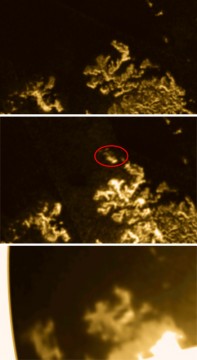Fleeting radar features in a sea in Titan’s northern hemisphere are a tantalizing possibility of seasonal changes.
Summer is coming to Titan’s northern hemisphere. The region is more than halfway to its next summer solstice in May 2017, with the vernal equinox having passed in August 2009. (And I thought Boston winters were long.)
NASA’s Cassini spacecraft has been flying around Saturn and its moons since 2004, and it has revealed river deltas and seasonal lakes on this haze-shrouded moon. Thus far the lakes have looked eerily smooth, but planetary scientists have suspected that, as summer approaches, wind speeds might rise in the northern hemisphere and blow ripples across the ethane-dominated seas.

NASA/JPL-Caltech/ASI/Cornell
Although not clearly waves, transient features detected by Cassini in the northern sea Ligeia Mare might be related to the change in seasons. Writing in Nature Geoscience, Jason Hofgartner (Cornell University) and colleagues report the detection of a small assemblage of radar features spanning an area about 20 km on a side that appeared and disappeared in the sea.
The features lie off the coast of a peninsula and appear in observations taken July 10, 2013, but they are absent from subsequent images from July 26th, September 12th, and October 14th of that year. Observations from 2009 also don’t show them; an image from May 2013 doesn’t seem to, either, although the resolution is much poorer for that image and it’s hard to say.
The radar features don’t match what’d be expected for image artifacts or permanent structures, the authors argue. Nor could tides have momentarily revealed a submerged part of the peninsula, because Cassini took the July 10th image — as well as those from right before and after — when the moon was in the same part of its orbit around Saturn.
Instead, the most likely explanations are some sort of temporary thingamajigs, such as waves, bubbles (perhaps of gas released from the sea floor thanks to changing temperatures), or solids (such as the Titan version of silt) suspended or floating in the sea.
If one of these options pans out, it won’t be a surprise. Rather, the features uphold our growing picture of Titan as a world of complex geology, hydrology, and meteorology, a place that might have methane rain and fog and even occasional torrential storms.
Reference: J. D. Hofgartner et al. "Transient features in a Titan sea." Nature Geoscience. Published online July 22, 2014.
Download our March 2013 issue to read more about evidence for methane rain and fog on Saturn's moon Titan.
 4
4









Comments
Peter Rowen
June 23, 2014 at 6:42 pm
Could it be waves generated by wind coming around that headland? Seems like kind of a large area for that, though.
You must be logged in to post a comment.
June 27, 2014 at 5:25 pm
Maybe some form of earthquake that's pushed the land or ? up from under the surface, would be great to have HD shots though.
You must be logged in to post a comment.
Kevin
June 29, 2014 at 12:56 pm
I suspect that the image can be explained through tectonic activity. It seems reasonable to assume that the levels in these ethane lakes and seas will periodically change their "sea levels" perhaps through tectonic action which might temporarily drain these bodies of liquid. They would then be refilled either through precipitation or by an up welling of subsurface fluids; in other words, a spring.
In the middle image, the peninsula on the left hand side appears to have more land exposed: This would help explain the mass in question appearing (and disappearing) at the end of the peninsula. It may lie just a few meters beneath the average sea level and only make an appearance as these levels change. Terrestrial geologic and atmospheric explanations might not translate exactly on Titan, but it's the only reference we have...until we land a rover there which I hope will be sooner than later!
You must be logged in to post a comment.
William-Townsend
June 29, 2014 at 9:36 pm
With a planet the size of Saturn that close I would suspect a simple high tide and low tide.
You must be logged in to post a comment.
You must be logged in to post a comment.